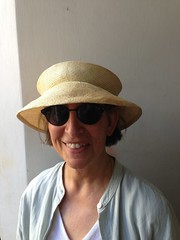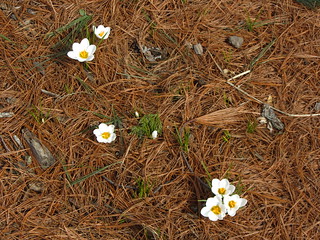
I'm a writer, publishing both as SJ Rozan and, with Carlos Dews, as Sam Cabot. (I'm Sam, he's Cabot.) Here you can find links to my almost-daily blog posts, including the Saturday haiku I've been doing for years. BUT the blog itself has moved to my website. If you go on over there you can subscribe and you'll never miss a post. (Miss a post! A scary thought!) Also, I'll be teaching a writing workshop in Italy this summer -- come join us!
Read/Post Comments (3)

What's the news from Xi'an? Is the Emperor well?
These entries have been coming fast and furious, and you might be getting the impression we're doing a town a day. Not so. I'm catching up on the blogs I've been unable to post, because sometimes I can't find a way to get online and sometimes I don't have the time. In reality we've been spending 3 days in each city, seeing the "art and heritage" sights in the main body of the day, and in my case prowling the streets early morning and evening. That's as interesting to me as the art -- though the art is astounding, and in some cases new to me, who thought I had a reasonably wide, if shallow, knowledge of Asian art.
This blog is coming to you from Dunhuang, and it's about Dunhuang, so I'm sort of caught up. We're leaving today for Turpan, though, so I'll probably slip behind again. But here goes.
The ancient Silk Road is so called because to Europeans its most astounding product was silk, which the Chinese had already been producing for 3,000 years when trade with the near east and from there to Europe began. The Chinese kept the methods of silk manufacture, weaving and dyeing a deep dark secret as long as they could, and the demand in south Asia, the near east and Europe was enormous. The trade along the route also included spices, plants, musical instruments, animals -- traders going east introduced large dogs into China, which had only little ones until then -- and vast numbers of other goods, anything the traders thought they could sell. It was lucrative, and it had to be, because it was a brutal and terrifying trip. The end, or beginning, of the Silk Road -- which wasn't really a road, but a network of three main routes, plus a fourth across Mongolia -- was Xi'an. Xi'an was the capital of China in those days. Beyond Xi'an China opened into desert. You had to go through the Jieyuguan Pass on the Gobi, but the Gobi there is at least scrub, and the oases not too widely spaced. But from Dunhuang you went out the Jade Gate pass into true wilderness. That was no longer China -- it was scrub and sand dunes, inhabited by wild beasts and bandits, and it was incomprehensibly huge. Vast distances separated oases: distances of blowing sand, burning sun, and no way to tell you were making progress except to keep your shadow in the right place so you wouldn't go around in circles.
We went way out in the desert -- in a bus and it was still an astonishing experience of distance -- to see the gates and passes. There's a famous poem by Wang Wei, a celebrated Tang dynasty poet:
"Stay and drink another cup of wine.
Beyond the gate you will not meet an old friend again."
The desolation is, even now, breathtaking. We rode camels on a sand dune in the Gobi. As we were headed back, another group was heading out toward us. It was thrilling see colors against that relentless glaring brown sand, and I got a tiny glimmer of what it might have been like to meet another caravan, to unpack your tents and share a meal with them, get the news -- months old -- from the east and give them yours from the west. Is the oasis dry? Where are the bandits? It gave me a shiver.
Then the 21st century re-asserted itself. We climbed a dune and sand-boarded down.
This blog is coming to you from Dunhuang, and it's about Dunhuang, so I'm sort of caught up. We're leaving today for Turpan, though, so I'll probably slip behind again. But here goes.
The ancient Silk Road is so called because to Europeans its most astounding product was silk, which the Chinese had already been producing for 3,000 years when trade with the near east and from there to Europe began. The Chinese kept the methods of silk manufacture, weaving and dyeing a deep dark secret as long as they could, and the demand in south Asia, the near east and Europe was enormous. The trade along the route also included spices, plants, musical instruments, animals -- traders going east introduced large dogs into China, which had only little ones until then -- and vast numbers of other goods, anything the traders thought they could sell. It was lucrative, and it had to be, because it was a brutal and terrifying trip. The end, or beginning, of the Silk Road -- which wasn't really a road, but a network of three main routes, plus a fourth across Mongolia -- was Xi'an. Xi'an was the capital of China in those days. Beyond Xi'an China opened into desert. You had to go through the Jieyuguan Pass on the Gobi, but the Gobi there is at least scrub, and the oases not too widely spaced. But from Dunhuang you went out the Jade Gate pass into true wilderness. That was no longer China -- it was scrub and sand dunes, inhabited by wild beasts and bandits, and it was incomprehensibly huge. Vast distances separated oases: distances of blowing sand, burning sun, and no way to tell you were making progress except to keep your shadow in the right place so you wouldn't go around in circles.
We went way out in the desert -- in a bus and it was still an astonishing experience of distance -- to see the gates and passes. There's a famous poem by Wang Wei, a celebrated Tang dynasty poet:
"Stay and drink another cup of wine.
Beyond the gate you will not meet an old friend again."
The desolation is, even now, breathtaking. We rode camels on a sand dune in the Gobi. As we were headed back, another group was heading out toward us. It was thrilling see colors against that relentless glaring brown sand, and I got a tiny glimmer of what it might have been like to meet another caravan, to unpack your tents and share a meal with them, get the news -- months old -- from the east and give them yours from the west. Is the oasis dry? Where are the bandits? It gave me a shiver.
Then the 21st century re-asserted itself. We climbed a dune and sand-boarded down.
Read/Post Comments (3)
Previous Entry :: Next Entry
Back to Top